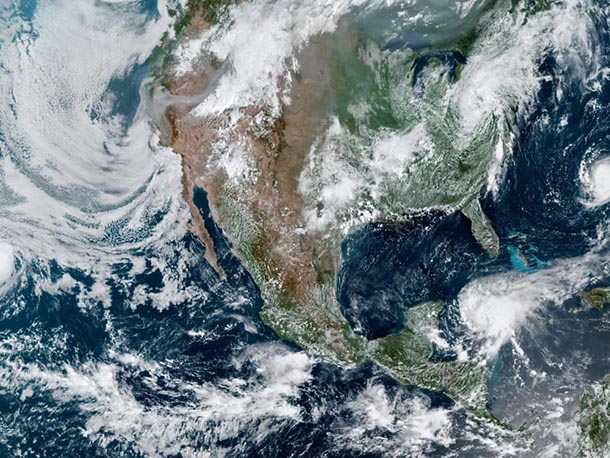
This satellite image captured in August 2021 over North America shows multiple storms offshore and smoke streaming over the continent. IMAGE: NASA
Penn State joins $72 million NASA consortium to study Earth system science
11/11/2021
By Matthew Carroll
UNIVERSITY PARK, Pa. — Understanding how Earth and its atmosphere behave in their natural settings and under the impact of human influence is the focus of a new $72 million consortium funded by the NASA Goddard Space Flight Center.
Penn State is joining the Goddard Earth Sciences Technology and Research (GESTAR II) consortium, which seeks to improve our understanding of the Earth system and our ability to observe, model and predict its environmental changes.
“We are delighted to be a partner in GESTAR II,” said Jose D. Fuentes, professor of meteorology and John T. Ryan Jr. Faculty Fellow, and a co-principal investigator on the project. “We very much look forward to interacting with the other partnering institutions and NASA Goddard Space Flight Center through our research and academic training.”
The University of Maryland, Baltimore County and Morgan State University are leading the three-year project, which will support 120 researchers to conduct observational, experimental and theoretical Earth and atmospheric science research.
“Penn State is a world leader in meteorology and atmospheric science research,” said Lora Weiss, Penn State’s senior vice president for research. “We look forward to bringing our extensive expertise in fields like weather forecasting, precipitation processes and air chemistry to this important NASA program.”
According to collaborator Wei Peng, assistant professor of civil and environmental engineering and international affairs, the project will help provide useful information to decision makers of the distribution of health impacts based on an improved understanding of atmospheric sciences.
“Together with colleagues in Penn State’s Department of Meteorology, we will assess air pollution exposure levels at a fine spatial scale to understand the distribution of health effects and potential environmental justice implications,” Peng said. “As a policy researcher, I am excited about this opportunity to use NASA satellites to help solve real-world problems on air quality, health and inequality.”
A major emphasis of the consortium is training the next generation of undergraduate and graduate students and providing a pipeline for them to go on to jobs at NASA and elsewhere.
“Our students in the Department of Meteorology and Atmospheric Sciences go on to do great things,” said Lee Kump, John Leone Dean in the College of Earth and Mineral Sciences. “We are excited for the additional opportunities this new partnership will provide, and for the contributions to Earth sciences that our students will make during their careers.”
Additionally, the consortium pairs Penn State with two Minority Serving Institutions, opening the doors for new collaboration, insights and innovations, Fuentes said.
“This will be a great opportunity for us to connect with colleagues and students at Minority Serving Institutions that are also a part of GESTAR II,” said Anthony Didlake Jr., assistant professor of meteorology at Penn State. “We’ll be contributing to the training of the next generation of NASA scientists, including the mentoring of graduate students from diverse backgrounds.”
Penn State will receive $1.4 million in initial funding for work on three research themes focusing on data assimilation, observations of convective boundary layer depth and atmospheric composition and climate.
“We have broad expertise in many areas of weather research that can help advance the current and future goals of NASA’s Earth science mission,” Didlake said. “I look forward to collaborating with NASA scientists on work in my area of expertise, which is hurricane and severe weather dynamics.”
In one example of GESTAR II research, Penn State scientists will use NASA satellite observations, high resolution numerical weather predictions models and advanced data assimilation techniques to study the roles of tropical thunderstorms in global weather and climate.
“Thunderstorms provide much of the rainfall over the tropics and have significant impacts on global weather and climate, but these systems often occur over regions with sparse observations,” said Xingchao Chen, assistant professor of meteorology at Penn State. “Using advanced data assimilation techniques, we will combine NASA’s satellite measurements with numerical weather simulations to produce an unprecedented high-resolution dataset for tropical thunderstorms.”
Another team of researchers will examine how sea breezes, a critical aspect of coastal meteorology, are capable of initiating and intensifying summertime thunderstorms.
“Fundamental questions remain regarding variability in their structure based on time of day, month, coastline geography, and the larger surrounding weather patterns, which in turn limits our ability to predict coastal storms,” said Kelly Lombardo, associate professor of meteorology and atmospheric science at Penn State. “Applying a novel radar-based approach, we will use observations to address these outstanding scientific questions toward improved prediction of hazardous thunderstorms over the densely populated eastern U.S. coastal zone.”
Other Penn State researchers on the GESTAR II project are David Stensrud, department head and professor of meteorology, Matthew Kumjian, associate professor of meteorology, and Yunji Zhang, assistant research professor of meteorology.
Colorado State, Arizona State, Northrop Grumman Corporation, Earth Resources Technology Inc. and the non-profit Southeastern University Research Association are among the other consortium partners.



